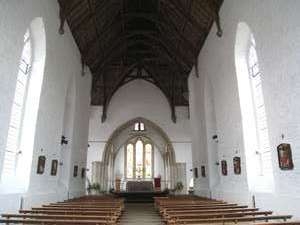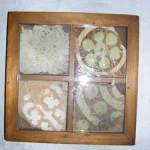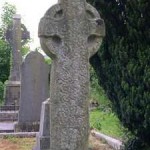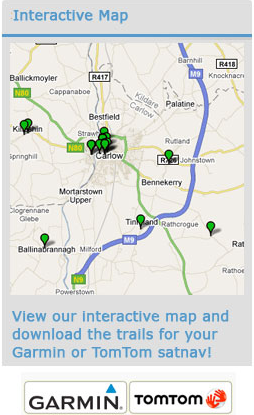Graiguenamanagh – Gráig na Manach – The grange of the Monks
A popular boating centre on the River Barrow whose character reflects a bygone time when the town was an important focal point for commercial boats. One of Ireland’s finest Cistercian monasteries was founded here in 1204 by William Marshal who became Lord of Leinster following his marriage to Strongbow’s daughter Isabel de Clare. It was called 12. Duiske Abbey from the stream that flows nearby. The Church was restored in 1974-80 and consists of a nave ![]() and chancel
and chancel ![]() with an aisle on each side. Although earlier restorations of 1813 and 1886 have covered much of the walls, the decoration of the capitals and the shapes of the arches can still be seen.
with an aisle on each side. Although earlier restorations of 1813 and 1886 have covered much of the walls, the decoration of the capitals and the shapes of the arches can still be seen.
To truly imagine what the church must have been like when the monks lived here, take a look at the chancel![]() , the crossing
, the crossing![]() and the east windows. The church originally had aisles extending along the full length of the nave on the south and the north.
and the east windows. The church originally had aisles extending along the full length of the nave on the south and the north.
Both aisles had seven Gothic-arched openings into the nave, each surmounted by twin-light clerestory windows. The original tiled paving is hidden one and a half meters under the present floor. Some of the original tiles are on display in the church. There is an excellent model of the original monastic settlement in the interior of the church.
During the restoration the roof was reconstructed from native timber using the original medieval techniques. In the baptistry off the south aisle is a very fine transitional doorway of early thirteenth-century date and the church also preserves a fine thirteenth-century effigy of a knight. Outside can be seen a portion of the remains of the conventual buildings including the chapter house and the sacristry with dormitory area overhead.
Originally the monastery would have spread over some five acres. In the graveyard to the south of the chancel there are two small granite high crosses. These would have been important educational tools of the time, bearing stories of early biblical significance.
 Open: Daily 9 a.m. – 6 p.m. summer, 9 a.m. – 5 p.m. winter
Open: Daily 9 a.m. – 6 p.m. summer, 9 a.m. – 5 p.m. winter
Admission: Free
Parking: Yes
![]() Nave: The main aisle of a church, occupied by the congregation.
Nave: The main aisle of a church, occupied by the congregation.
![]() Chancel: The eastern part of a church, usually where the main altar is situated.
Chancel: The eastern part of a church, usually where the main altar is situated.




Comments
Trackbacks